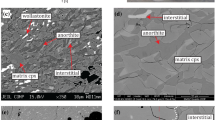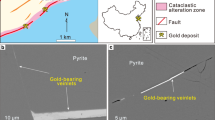Abstract
The use of trace elements (TE) as geochemical indicators is complicated by the dualism of their distribution coefficients D due to the additional (i.e., above the concentrations of an isomorphic component) incorporation of elements at structural defects of various nature (including the surface of the crystal). A pressing problem in this situation is to determine the true D values that pertain to the structural component of an admixture D str and evaluate effects of other modes of TE occurrence. Only upon distinguishing D str in the bulk coefficient D bulk it is possible to evaluate the ore potential of fluid in terms of certain TE from the composition of a mineral containing the TE. Pyrite synthesized in solutions of variable pH at 450°C and 1 kbar (100 MPa) at fluid portions sampled in a trap is utilized to demonstrate the role of a surface nonautonomous phase (NP) in the incorporation of gold in this mineral. The distribution coefficient of gold between pyrite and hydrothermal solution is 0.14 for “pure” pyrite and 0.05 for As-bearing pyrite (containing 0.02–0.05 wt % As), and these coefficients for NP are 310 and 170, respectively. This increases the D bulk for evenly distributed (“invisible”) gold by factors of four and nine. In contrast to the results of earlier studies conducted at room temperature and pressure or parameters close to them, our data demonstrate that the accumulation of “invisible” Au in pyrite is controlled not only by reducing adsorption with the development of Au(0) particles and films but also by Au incorporation in NP developing in the surface layer of the crystal approximately 500 nm thick as chemically bound Au [most likely as Au(I)]. The possible reason for the high absorption capacity of NP is the defect (pyrrhotite-like) structure, which is not saturated with bonds of excess S and sulfoxi onions.
Similar content being viewed by others
References
V. S. Urusov and I. F. Kravchuk, “Effect of the Entrapment of Trace Elements by Defects of Crystal Lattice and Its Geochemical Significance,” Geokhimiya, No. 7, 963–978 (1978).
V. V. Akimov and V. L. Tauson, “Accumulation of Trace Elements in Mosaic and Micrograined Mineral Crystals: Experimental Data,” Geokhimiya, No. 11, 1201–1210 (2003) [Geochem. Int. 41, 1099–1107 (2003)].
V. S. Urusov, V. L. Tauson, and V. V. Akimov, Geochemistry of the Solid (GEOS, Moscow, 1997) [in Russian].
V. L. Tauson, “Systematics of Processes of Trace Element Uptake by Real Mineral Crystals,” Geokhimiya, No. 2, 213–219 (2005) [Geochem. Int. 43, 184–190 (2005)].
V. S. Urusov, “Energetic Formulation of Problems of Equilibrium Cocrystallization from Aqueous Solution,” Geokhimiya, No. 5, 627–644 (1980).
L. V. Chernyshev, “To the Theory of Hydrothermal Equilibria of Minerals of Variable Composition,” Geokhimiya, No. 6, 787–797 (1980).
V. L. Tauson, I. Yu. Parkhomenko, D. N. Babkin, et al., “Cadmium and Mercury Uptake by Galena Crystals under Hydrothermal Growth: A Spectroscopic and Element Thermo-Release Atomic Absorption Study,” Eur. J. Mineral 17, 599–610 (2005).
V. L. Tauson, “The Principle of Continuity of Phase Formation at Mineral Surfaces,” Dokl. Akad. Nauk 425(5), 668–673 (2009) [Dokl. Earth Sci. 425, 471–475 (2009)].
A. V. Kuklinskii, Yu. L. Mikhlin, G. L. Pashkov, et al., “Conditions for the Formation of a Nonequilibrium Nonstoichiometric Layer on Pyrrhotite in Acid Solutions,” Elektrokhimiya 37(12), 1458–1465 (2001) [Russ. J. Elektrochem. 37, 1269–1276 (2001)].
J. Watt, S. Cheong, M. F. Toney, et al., “Ultrafast Growth of Highly Branched Palladium Nanostructures for Catalysis,” ACS Nano 4(1), 396–402 (2010).
V. L. Tauson and N. V. Smagunov, “Influence of Associated Elements of Gold on Its Behavior in Fe-S-Aqueous-Salt Solution at Temperature of 450°C and Pressure of 100 MPa,” Russian Geol. Geophys. 38(3), 706–713 (1997).
V. L. Tauson, D. N. Babkin, E. E. Lustenberg, et al., “Surface Typochemistry of Hydrothermal Pyrite: Electron Spectroscopic and Scanning Probe Microscopic Data. I. Synthetic Pyrite,” Geokhimiya, No. 6, 615–628 (2008) [Geochem. Int. 46, 565–577 (2008)].
V. L. Tauson, O. I. Bessarabova, R. G. Kravtsova, et al., “On Separation of Modes of Gold Occurrences in Pyrites by Means of Studying Statistical Samplings of Analytical Data,” Russian Geol. Geophys. 43(1), 56–64 (2002).
V. L. Tauson and E. E. Lustenberg, “Quantitative Determination of Modes of Gold Occurrence in Minerals by the Statistical Analysis of Analytical Data Samplings,” Geokhimiya, No. 4, 459–464 (2008) [Geochem. Int. 46, 423–427 (2008)].
V. L. Tauson, T. M. Pastushkova, D. N. Babkin, et al., “Effect of Particle Size Variation in a Sample on Trace Element Concentration,” Dokl. Akad. Nauk 429(6), 809–815 (2009) [Dokl. Earth Sci. 429a, 1590–1596 (2009)].
V. L. Tauson, T. M. Pastushkova, and O. I. Bessarabova, “On the Limit and Modes of Gold Incorporation in the Hydrothermal Pyrite,” Russian Geol. Geophys. 39(7), 932–940 (1998).
Yu. V. Laptev and K. B. Rozov, “Interaction of Gold with Sulfide Surface as a Factor of Its Concentration in Hydrothermal Ore Formation,” Dokl. Akad. Nauk 410(5), 663–667 (2006) [Dokl. Earth Sci. 410, 1229–1232 (2006)].
P. Möller, “Accumulation of Gold on Natural Sulfides: The Electrochemical Function of Arsenic in Nature,” Geol. Jb. D100, 639–660 (1994).
M. Reich, S. E. Kesler, S. Utsunomiya, et al., “Solubility of Gold in Arsenian Pyrite,” Geochim. Cosmochim. Acta 69, 2781–2796 (2005).
P. G. Spry, S. Chryssoulis, and C. G. Ryan, “Process Mineralogy of Gold: Gold from Tellurium-Bearing Ores,” J. Miner., Met., Mater. Soc. 56, 60–62 (2004).
G. Simon, H. Huang, J. E. Penner-Hahn, et al., “Oxidation State of Gold and Arsenic in Gold-Bearing Arsenian Pyrite,” Am. Mineral. 84, 1071–1079 (1999).
D. W. Pals, P. G. Spry, and S. Chryssoulis, “Invisible Gold and Tellurium in Arsenic-Rich Pyrite from the Emperor Gold Deposit, Fiji: Implications for Gold Distribution and Deposition,” Econ. Geol. 98, 479–493 (2003).
S. H. McClenaghan, D. R. Lentz, and L. J. Cabri, “Abundance and Speciation of Gold in Massive Sulfides of the Bathurst Mining Camp, New Brunswick, Canada,” Can. Mineral. 42, 851–871 (2004).
G. Bancroft and G. Jean, “Gold Deposition at Low Temperature on Sulfide Minerals,” Nature 298(5876), 730–731 (1982).
G. M. Bancroft and M. E. Hyland, “Spectroscopic Studies of Adsorption/Reduction Reactions of Aqueous Metal Complexes on Sulfide Surfaces,” Rev. Mineral. 23, 511–558 (1990).
G. E. Jean and G. M. Bancroft, “An XPS and SEM Study of Gold Deposition at Low Temperatures on Sulphide Mineral Surfaces: Concentration of Gold by Adsorption/Reduction,” Geochim. Cosmochim. Acta 49, 979–987 (1985).
S. V. Kozerenko, A. M. Tuzova, I. M. Rodionova, et al., “One of the Mechanisms for the Formation of Finely Dispersed Gold in Iron Sulfides,” Geokhimiya, No. 12, 1706–1714 (1986).
J. R. Mycroft, G. M. Bancroft, N. S. McIntyre, and J.W. Lorimer, “Spontaneous Deposition of Gold on Pyrite from Solutions Containing Au(III) and Au(I) Chlorides. Part I: A Surface Study,” Geochim. Cosmochim. Acta 59, 3351–3365 (1995).
M. J. Scaini, G. M. Bancroft, and S. W. Knipe, “An XPS, AES, and SEM Study of the Interactions of Gold and Silver Chloride Species with PbS and FeS2: Comparison to Natural Samples,” Geochim. Cosmochim. Acta 61, 1223–1231 (1997).
L. M. Maddox, G. M. Bancroft, M. J. Scaini, and J.W. Lorimer, “Invisible Gold: Comparison of Au Deposition on Pyrite and Arsenopyrite,” Am. Mineral. 83, 1240–1245 (1998).
Yu. L. Mikhlin and A. S. Romanchenko, “Gold Deposition on Pyrite and the Common Sulfide Minerals: An STM/STS and SR-XPS Study of Surface Reactions and Au Nanoparticles,” Geochim. Cosmochim. Acta 71, 5985–6001 (2007).
Author information
Authors and Affiliations
Corresponding author
Additional information
Original Russian Text © V.L. Tauson, D.N. Babkin, T.M. Pastushkova, T.S. Krasnoshchekova, E.E. Lustenberg, O.Yu. Belozerova, 2011, published in Geokhimiya, 2011, Vol. 49, No. 6, pp. 595–604.
Rights and permissions
About this article
Cite this article
Tauson, V.L., Babkin, D.N., Pastushkova, T.M. et al. Dualistic distribution coefficients of elements in the system mineral-hydrothermal solution. I. Gold accumulation in pyrite. Geochem. Int. 49, 568–577 (2011). https://doi.org/10.1134/S0016702911060097
Received:
Published:
Issue Date:
DOI: https://doi.org/10.1134/S0016702911060097




